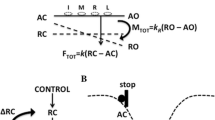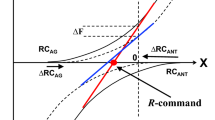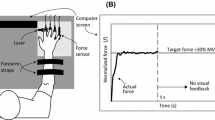Abstract
We used the theory of control with spatial referent coordinates (RC) to explore how young, healthy persons modify finger pressing force and match forces between the two hands. Three specific hypotheses were tested related to patterns of RC and apparent stiffness (defined as the slope of force-coordinate relation) used in the presence of visual feedback on the force and in its absence. The subjects used the right hand to produce accurate force under visual feedback; further the force could be increased or decreased, intentionally or unintentionally (induced by controlled lifting or lowering of the fingertips). The left hand was used to match force without visual feedback before and after the force change; the match hand consistently underestimated the actual force change in the task hand. The “inverse piano” device was used to compute RC and apparent stiffness. We found very high coefficients of determination for the inter-trial hyperbolic regressions between RC and apparent stiffness in the presence of visual feedback; the coefficients of determination dropped significantly without visual feedback. There were consistent preferred sharing patterns in the space of RC and apparent stiffness between the task and match hands across subjects. In contrast, there was much less consistency between the task and match hands in the magnitudes of RC and apparent stiffness observed in individual trials. Compared to the task hand, the match hand showed consistently lower magnitudes of apparent stiffness and, correspondingly, larger absolute magnitudes of RC. Involuntary force changes produced by lifting and lowering the force sensors led to significantly lower force changes compared to what could be expected based on the computed values of apparent stiffness and sensor movement amplitude. The results confirm the importance of visual feedback for stabilization of force in the space of hypothetical control variables. They suggest the existence of personal traits reflected in preferred ranges of RC and apparent stiffness across the two hands. They also show that subjects react to external perturbations, even when instructed “not to interfere”: Such perturbations cause unintentional and unperceived drifts in both RC and apparent stiffness.









Similar content being viewed by others
Reference
Ambike S, Zatsiorsky VM, Latash ML (2015a) Processes underlying unintentional finger force changes in the absence of visual feedback. Exp Brain Res 233:711–721
Ambike S, Zhou T, Zatsiorsky VM, Latash ML (2015b) Moving a hand-held object: reconstruction of referent coordinate and apparent stiffness trajectories. Neurosci 298:336–356
Ambike S, Mattos D, Zatsiorsky VM, Latash ML (2016a) Synergies in the space of control variables within the equilibrium-point hypothesis. Neurosci 315:150–161
Ambike S, Mattos D, Zatsiorsky VM, Latash ML (2016b) Unsteady steady-states: central causes of unintentional force drift. Exp Brain Res 234:3597–3611
Asatryan DG, Feldman AG (1965) Functional tuning of the nervous system with control of movements or maintenance of a steady posture. I. Mechanographic analysis of the work of the limb on execution of a postural task. Biophysics 10:925–935
Barto AG, Fagg AH, Sitkoff N, Houk JC (1999) A cerebellar model of timing and prediction in the control of reaching. Neural Comput 11:565–594
Bernstein NA (1947) On the construction of movements. Medgiz, Moscow (in Russian)
Bernstein NA (1967) The co-ordination and regulation of movements. Pergamon Press, Oxford
Cuadra C, Latash ML (2019) Exploring the concept of iso-perceptual manifold (IPM): a study of finger force matching. Neurosci 401:130–141
Cuadra C, Wojnicz W, Kozinc Z, Latash ML (2020) Perceptual and motor effects of muscle co-activation in a force production task. Neurosci 437:34–44
Decety J, Lindgren M (1991) Sensation of effort and duration of mentally executed actions. Scand J Psychol 32:97–104
De Freitas PB, Freitas SMSF, Lewis MM, Huang X, Latash ML (2018) Stability of steady hand force production explored across spaces and methods of analysis. Exp Brain Res 236:1545–1562
De Freitas PB, Freitas SMSF, Lewis MM, Huang X, Latash ML (2019) Individual preferences in motor coordination seen across the two hands: relations to movement stability and optimality. Exp Brain Res 237:1–13
Feldman AG (1966) Functional tuning of the nervous system with control of movement or maintenance of a steady posture. II Controllable parameters of the muscle. Biophysics 11:565–578
Feldman AG (1980) Superposition of motor programs. I Rhythmic forearm movements in man. Neurosci 5:81–90
Feldman AG (1986) Once more on the equilibrium-point hypothesis (λ-model) for motor control. J Motor Behav 18:17–54
Feldman AG (2009) New insights into action-perception coupling. Exp Brain Res 194:39–58
Feldman AG (2015) Referent control of action and perception: challenging conventional theories in behavioral science. Springer, New York
Feldman AG (2016) Active sensing without efference copy: referent control of perception. J Neurophysiol 116:960–976
Feldman AG, Levin MF (1995) Positional frames of reference in motor control: their origin and use. Behav Brain Sci 18:723–806
Gielen CC, Houk JC (1987) A model of the motor servo: incorporating nonlinear spindle receptor and muscle mechanical properties. Biol Cybern 57:217–231
Gorniak S, Zatsiorsky VM, Latash ML (2007) Hierarchies of synergies: an example of the two-hand, multi-finger tasks. Exp Brain Res 179:167–180
Gottlieb GL (1998) Rejecting the equilibrium-point hypothesis. Mot Control 2:10–12
Gottlieb GL, Agarwal GC (1986) The invariant characteristic isn't. Behav Brian Sci 9:608–609
Gottlieb GL, Agarwal GC (1988) Compliance of single joints: elastic and plastic characteristics. J Neurophysiol 59:937–951
Gribble PL, Ostry DJ, Sanguineti V, Laboissiere R (1998) Are complex control signals required for human arm movements? J Neurophysiol 79:1409–1424
Gurari N, van der Helm NA, Drogos JM, Dewald JPA (2019) Accuracy of individuals post-hemiparetic stroke in matching torques between arms depends on the arm referenced. Front Neurol 10:921
Haar S, Dinstein I, Shelef I, Donchin O (2017a) Effector-invariant movement encoding in the human motor system. J Neurosci 37:9054–9063
Haar S, Donchin O, Dinstein I (2017b) Individual movement variability magnitudes are explained by cortical neural variability. J Neurosci 37:9076–9085
Ilmane N, Sangani S, Feldman AG (2013) Corticospinal control strategies underlying voluntary and involuntary wrist movements. Behav Brain Res 236:350–358
Koh TJ, Grabiner MD, Clough CA (1993) Bilateral deficit is larger for step than for ramp isometric contractions. J Appl Physiol 74:1200–1205
Latash ML (1992) Virtual trajectories, joint stiffness, and changes in natural frequency during single-joint oscillatory movements. Neurosci 49:209–220
Latash ML (1994) Reconstruction of equilibrium trajectories and joint stiffness patterns during single-joint voluntary movements under different instructions. Biol Cybern 71:441–450
Latash ML (2008) Synergy. Oxford University Press, New York
Latash ML (2010) Motor synergies and the equilibrium-point hypothesis. Mot Control 14:294–322
Latash ML (2012) The bliss (not the problem) of motor abundance (not redundancy). Exp Brain Res 217:1–5
Latash ML (2016) Towards physics of neural processes and behavior. Neurosci Biobehav Rev 69:136–146
Latash ML (2018a) Stability of kinesthetic perception in efferent-afferent spaces: the concept of iso-perceptual manifold. Neurosci 372:97–113
Latash ML (2018b) Muscle co-activation: definitions, mechanisms, and functions. J Neurophysiol 120:88–104
Latash ML (2019) Physics of biological action and perception. Academic Press, New York
Latash ML, Gottlieb GL (1991) Reconstruction of elbow joint compliant characteristics during fast and slow voluntary movements. Neurosci 43:697–712
Latash ML, Shim JK, Smilga AV, Zatsiorsky V (2005) A central back-coupling hypothesis on the organization of motor synergies: a physical metaphor and a neural model. Biol Cybern 92:186–191
Latash ML, Scholz JP, Schöner G (2002) Motor control strategies revealed in the structure of motor variability. Exer Sport Sci Rev 30:26–31
Latash ML, Scholz JP, Schöner G (2007) Toward a new theory of motor synergies. Mot Control 11:276–308
Latash ML, Zatsiorsky VM (1993) Joint stiffness: Myth or reality? Hum Move Sci 12:653–692
Li S, Danion F, Latash ML, Li Z-M, Zatsiorsky VM (2001) Bilateral deficit and symmetry in finger force production during two-hand multi-finger tasks. Exp Brain Res 141:530–540
Li S, Leonard CT (2006) The effect of enslaving on perception of finger forces. Exp Brain Res 172:301–309
Li Z-M, Latash ML, Zatsiorsky VM (1998) Force sharing among fingers as a model of the redundancy problem. Exp Brain Res 119:276–286
Martin V, Scholz JP, Schöner G (2009) Redundancy, self-motion, and motor control. Neural Comput 21:1371–1414
Martin JR, Budgeon MK, Zatsiorsky VM, Latash ML (2011) Stabilization of the total force in multi-finger pressing tasks studied with the ‘inverse piano’ technique. Hum Move Sci 30:446–458
Mitchell M, Martin BJ, Adamo DE (2017) Upper limb asymmetry in the sense of effort is dependent on force level. Front Psychol 8:643
Park J, Wu Y-H, Lewis MM, Huang X, Latash ML (2012) Changes in multi-finger interaction and coordination in Parkinson’s disease. J Neurophysiol 108:915–924
Park WH, Leonard CT, Li S (2008) Finger force perception during ipsilateral and contralateral force matching tasks. Exp Brain Res 189:301–310
Parsa B, O’Shea DJ, Zatsiorsky VM, Latash ML (2016) On the nature of unintentional action: a study of force/moment drifts during multi-finger tasks. J Neurophysiol 116:698–708
Proske U, Gandevia SC (2012) The proprioceptive senses: their roles in signaling body shape, body position and movement, and muscle force. Physiol Rev 92:1651–1697
Proske U, Allen T (2019) The neural basis of the senses of effort, force and heaviness. Exp Brain Res 237:589–599
Rasouli O, Solnik S, Furmanek MP, Piscitelli D, Falaki A, Latash ML (2017) Unintentional drifts during quiet stance and voluntary body sway. Exp Brain Res 235:2301–2316
Reschechtko S, Latash ML (2017) Stability of hand force production: I. Hand level control variables and multi-finger synergies. J Neurophysiol 118:3152–3164
Reschechtko S, Latash ML (2018) Stability of hand force production. II. Ascending and descending synergies. J Neurophysiol 120(3):1045–1060
Reschechtko S, Zatsiorsky VM, Latash ML (2014) Stability of multi-finger action in different spaces. J Neurophysiol 112:3209–3218
Reschechtko S, Zatsiorsky VM, Latash ML (2017) The synergic control of multi-finger force production: stability of explicit and implicit task components. Exp Brain Res 235:1–14
Reschechtko S, Cuadra C, Latash ML (2018) Force illusions and drifts observed during muscle vibration. J Neurophysiol 119:326–336
Sainburg RL (2005) Handedness: differential specializations for control of trajectory and position. Exer Sport Sci Rev 33:206–213
Sanes JN, Shadmehr R (1995) Sense of muscular effort and somesthetic afferent information in humans. Can J Physiol Pharmacol 73:223–233
Savage G, Allen TJ, Proske U (2015) The senses of active and passive forces at the human ankle joint. Exp Brain Res 233:2167–2180
Scholz JP, Schöner G (1999) The uncontrolled manifold concept: identifying control variables for a functional task. Exp Brain Res 126:289–306
Scotland S, Adamo DE, Martin BJ (2014) Sense of effort revisited: relative contributions of sensory feedback and efferent copy. Neurosci Lett 561:208–212
Shergill SS, Bays PM, Frith CD, Wolpert DM (2003) Two eyes for an eye: the neuroscience of force escalation. Science 301(5630):187
Sperry RW (1950) Neural basis of the spontaneous optokinetic response produced by visual inversion. J Comp Physiol Psychol 43:482–489
Ting LH (2007) Dimensional reduction in sensorimotor systems: a framework for understanding muscle coordination of posture. Prog Brain Res 165:299–321
Tresch MC, Cheung VC, d'Avella A (2006) Matrix factorization algorithms for the identification of muscle synergies: evaluation on simulated and experimental data sets. J Neurophysiol 95:2199–2212
Tresch MC, Jarc A (2009) The case for and against muscle synergies. Curr Opin Neurobiol 19:601–607
Ustinova KI, Feldman AG, Levin MF (2006) Central resetting of neuromuscular steady states may underlie rhythmical arm movements. J Neurophysiol 96:1124–1134
Vaillancourt DE, Russell DM (2002) Temporal capacity of short-term visuomotor memory in continuous force production. Exp Brain Res 145:275–285
Van Doren CL (1995) Pinch force matching errors predicted by an equilibrium-point model. Exp Brain Res 106:488–492
Van Doren CL (1998) Differential effects of load stiffness on matching pinch force, finger span, and effort. Exp Brain Res 120:487–495
Von Holst E, Mittelstaedt H (1950/1973) The reafference principle. In: The Behavioral Physiology of Animals and Man. The Collected Papers of Erich von Holst. (trans: Martin R). University of Miami Press, Florida, 1:139–173
Voss M, Bays PM, Rothwell JC, Wolpert DM (2007) An improvement of perception of self-generated tactile stimuli following theta-burst stimulation of primary motor cortex. Neuropsychologia 45:2712–2717
Wilhelm L, Zatsiorsky VM, Latash ML (2013) Equifinality and its violations in a redundant system: multi-finger accurate force production. J Neurophysiol 110:1965–1973
Zhou T, Solnik S, Wu Y-H, Latash ML (2014) Unintentional movements produced by back-coupling between the actual and referent body configurations: violations of equifinality in multi-joint positional tasks. Exp Brain Res 232:3847–3859
Author information
Authors and Affiliations
Corresponding author
Additional information
Communicated by Francesco Lacquaniti.
Publisher's Note
Springer Nature remains neutral with regard to jurisdictional claims in published maps and institutional affiliations.
Rights and permissions
About this article
Cite this article
Abolins, V., Cuadra, C., Ricotta, J. et al. What do people match when they try to match force? Analysis at the level of hypothetical control variables. Exp Brain Res 238, 1885–1901 (2020). https://doi.org/10.1007/s00221-020-05850-7
Received:
Accepted:
Published:
Issue Date:
DOI: https://doi.org/10.1007/s00221-020-05850-7




